Experimental and Numerical Study on the Performance of Steel–Coarse Aggregate Reactive Powder Concrete Composite Beams with Uplift-Restricted and Slip-Permitted Connectors under Negative Bending Moment
Abstract
:1. Introduction
2. Experimental Program
2.1. Test Setup
2.2. Specimens and Materials
- (1)
- The standard specimen CA-RPC-STD used a CA-RPC slab and applied a post-tensioning prestress of 900 kN with URSP connectors. The aim of the design was to observe the ultimate flexural capacity, flexural stiffness, relative slip between steel and concrete, and crack development in the concrete flange under negative bending moments. This specimen served as the standard for comparison with the other ones.
- (2)
- The specimen CA-RPC-SR used conventional studs at the interface between the steel beam and the concrete slab, while the other parameters were the same as the standard specimen. By comparing this specimen with CA-RPC-STD, the effect of URSP connectors on the mechanical performance of the beam was expected to be found.
- (3)
- The specimen CA-RPC-NPS removed the prestress, while the other parameters were the same as the standard specimen. By comparing this specimen with CA-RPC-STD, the effect of prestress on the mechanical performance of the beam was expected to be found.
- (4)
- In the specimen CA-RPC-NNS, a plastic film was set at the interface between the steel beam and the concrete slab to eliminate the bonding of the two materials, while the other parts were the same as the standard specimen. By comparing this specimen with CA-RPC-STD, the effect of bonding at the interface on the mechanical performance of the beam was expected to be found.
- (5)
- The specimen CA-RPC-ER also removed the prestress, and conventional studs were set at both ends of the beam instead of a part of URSP connectors. The only difference between this specimen and CA-RPC-NPS was that conventional bolt connectors were set at both ends of the beam instead of a part of URSP connectors in order to find out whether the URSP connector could still work well when the slip was restricted at both ends of the beam, which is an ordinary condition for continuous beams.
2.3. Measurement Device
- (1)
- A cross-section at the point of the maximum bending moment was selected to set the strain gauges. Additionally, a load cell was installed on the jack in order to monitor the magnitude of the applied load in real time.
- (2)
- A displacement meter was installed at the mid-span of the specimen to measure the deflection.
- (3)
- Several displacement meters were installed at the interface between the steel beam and the concrete slab along the longitudinal direction of the beam to measure the relative slip distribution.
3. Experimental Results
3.1. Force–Displacement Curves
- (1)
- Elastic stage. The corresponding load of this stage is approximately 0 to 0.85 Pu. The load–displacement curve is approximately linear, and the overall stiffness remains essentially constant in this stage.
- (2)
- Elastoplastic stage. The corresponding load of this stage is approximately 0.85 to 1.0 Pu. After reaching the yield load (approximately 0.85 Pu), the overall stiffness of the specimen rapidly decreases to nearly zero, and the load–displacement curve enters a plastic plateau. The longitudinal tensile reinforcement and the lower flange of the steel beam yield almost at the same time.
- (3)
- Stage of load-bearing capacity decrease. Once the load reaches the ultimate load-bearing capacity Pu, the lower flange of the steel beam undergoes buckling. Subsequently, the load begins to decrease with a low slope, which means that the specimen demonstrates good ductility.
3.2. Cracking Patterns
3.3. Strain of the Mid-Span Section
3.4. Slip at the Steel–Concrete Interface
4. Numerical Model
4.1. Material Models
4.2. Force–Displacement Relationship
4.3. Cracking Load
4.4. Failure Mode
4.5. Parameter Analysis
4.6. Calculation of Ultimate Strength by Eurocode 4
5. Conclusions
- (1)
- In the experiment, under negative bending moments, the utilization of CA-RPC materials, URSP connectors, and prestress all could enhance the cracking load of the beams. In addition, the combination of CA-RPC and URSP connectors would not cause a sharp increase in the cost and the difficulty of construction, which would be an optimized selection for the bridge industry.
- (2)
- The results of the strain distribution of the section at the mid-span of the beams indicated that with the use of URSP connectors instead of ordinary studs, there was a large slip at the interface of the two materials. Neutral axes were generated in the steel beam and the concrete slab, which could effectively reduce the tensile strain in the concrete. The measurement of interfacial slip also indicated that the application of URSP connectors allowed for greater slip at the interface.
- (3)
- By setting appropriate parameters, such as material constitutive properties and connection conditions, the numerical models could achieve computational results that are consistent with the experiment with enough accuracy. The models also show good simulation of the phenomenon observed in the experiment, so they can serve as a foundation for parameter analysis in subsequent research.
- (4)
- A parameter analysis of the FEM was carried out to study the influence of the application of the CA-RPC material, URSP connectors, and prestress on the cracking resistance of the composite beams, and it was indicated that using the CA-RPC material and prestress made great contributions, and the usage of URSP connectors could enhance the effect of the other two factors.
- (5)
- According to the experimental results and existing research, suggestions were proposed for the calculation method of the bearing capacity of steel–CA-RPC composite beams with URSP connectors. The computational results obtained by using the methods proposed in Eurocode 4 coincided with the experimental data and were more conservative.
Author Contributions
Funding
Data Availability Statement
Conflicts of Interest
Nomenclature
| Fcr | cracking load; |
| Fy | yield load; |
| Pu | ultimate load-bearing capacity; |
| f0 | peak compressive stress of CA-RPC; |
| ε0 | peak compressive strain of CA-RPC; |
| E | elastic modulus of CA-RPC; |
| Vf | steel fiber volume fraction; |
| εcr | crack strain of CA-RPC; |
| fcr | crack tensile stress of CA-RPC; |
| ft | peak tensile stress of CA-RPC; |
| εt | peak tensile strain of CA-RPC; |
| fy | yield stress of steel or rebar; |
| Es | elastic modulus of steel or rebar; |
| δ0 | maximum slip restrained by interfacial bonding effect; |
| k0 | stiffness of interfacial bonding effect; |
| Vu | ultimate shear capacity of the stud; |
| ts | thickness of the material with low elastic modulus; |
| δf | ultimate slip; |
| ds | diameter of the stud; |
| As | the section area of the stud; |
| f | yield stress of the stud; |
| Mpl,Rd | plastic resistance moment. |
References
- Zhang, Q.; Jia, D.; Bao, Y.; Dong, S.; Cheng, Z.; Bu, Y. Flexural behavior of steel–concrete composite beams considering interlayer slip. J. Struct. Eng. 2019, 145, 04019084. [Google Scholar] [CrossRef]
- Su, Q.; Yang, G.; Wu, C. Experimental Investigation on Inelastic Behavior of Composite Box Girder under Negative Moment. Int. J. Steel Struct. 2012, 12, 71–84. [Google Scholar] [CrossRef]
- Jiang, A.; Chen, J.; Jin, W. Experimental Study of Innovative Steel-Concrete Composite Beams Under Hogging Moment. Adv. Struct. Eng. 2013, 16, 877–886. [Google Scholar] [CrossRef]
- Xu, B.; Liu, Y.; Zhu, W. Comparative study on flexural behavior of steel-UHPC composite beams and steel-ordinary concrete composite beams in the negative moment zone. Structures 2023, 57, 105288. [Google Scholar] [CrossRef]
- Wu, W.; Dai, J.; Chen, L.; Liu, D.; Zhou, X. Experiment analysis on crack resistance in negative moment zone of steel-concrete composite continuous girder improved by interfacial slip. Materials 2022, 15, 8319. [Google Scholar] [CrossRef] [PubMed]
- Zhang, Y.; Cai, S.; Zhu, Y.; Fan, L.; Shao, X. Flexural responses of steel-UHPC composite beams under hogging moment. Eng. Struct. 2020, 206, 110134. [Google Scholar] [CrossRef]
- Wei, C.; Zhang, H.; Yang, Z.; Li, M.; Cheng, Z.; Bao, Y. Flexural cracking behavior of reinforced UHPC overlay in composite bridge deck with orthotropic steel deck under static and fatigue loads. Eng. Struct. 2022, 265, 114537. [Google Scholar] [CrossRef]
- Lin, J.; Lin, L.; Peng, Z.; Xu, R. Cracking performance in the hogging-moment regions of natural curing steel–UHPC and Steel–UHTCC continuous composite beams. J. Bridge Eng. 2022, 27, 04021106. [Google Scholar] [CrossRef]
- Cao, G.; Han, C.; Dai, Y.; Zhang, W. Long-term experimental study on prestressed steel–concrete composite continuous box beams. J. Bridge Eng. 2018, 23, 04018067. [Google Scholar] [CrossRef]
- Xiong, G.; Feng, L.; Zou, Y.; Wang, X.; Xie, J. Experimental study of high-strength steel-precast prestressed concrete composite beams under hogging moment. J. Constr. Steel Res. 2024, 219, 108784. [Google Scholar] [CrossRef]
- Nie, J.; Li, Y.; Tao, M.; Nie, X. Uplift-restricted and slip-permitted T-shape connectors. J. Bridge. Eng. 2015, 20, 04014073. [Google Scholar] [CrossRef]
- Nie, J.; Wang, J.; Gou, S.; Zhu, Y.; Fan, J. Technological development and engineering applications of novel steel–concrete composite structures. Front. Struct. Civ. Eng. 2019, 13, 1–14. [Google Scholar] [CrossRef]
- Duan, L.; Chen, H.; Nie, X.; Han, S. Experimental study on steel-concrete composite beams with uplift-restricted and slip-permitted screw-type (URSP-S) connectors. Steel Compos. Struct. 2020, 35, 261–278. [Google Scholar]
- Chen, Y.; Yan, Q.; Yu, X.; Jia, B.; Wu, Y.; Luo, Y. Experimental and Numerical Research on Uplift-Restricted and Slip-Permitted Screw-Shaped Connectors. Int. J. Steel Struct. 2022, 22, 225–239. [Google Scholar] [CrossRef]
- Jiang, Y.; Nie, X.; Yan, A.; Zeng, J.; Nong, X.; Fan, J. Experimental research on the structural performance of continuous composite beams with uplift-restricted and slip-permitted connectors. Eng. Struct. 2023, 289, 116291. [Google Scholar] [CrossRef]
- Cui, B.; Wu, H.; Zhao, C.; Liu, J.; Guo, Z. Steel-concrete composite cable-stayed bridge-main bridge of the Jiangxinzhou Yangtze River Bridge at Nanjing. Sturct. Eng. Int. 2021, 33, 107–114. [Google Scholar]
- Liu, Z.; Alsomiri, M.; Li, M.; Chen, X.; Meng, J. Experimental investigation on the flexural behavior of coarse aggregate reactive powder concrete (CA-RPC) bridge deck. Eng. Struct. 2022, 271, 114951. [Google Scholar] [CrossRef]
- Yazici, H.; Yardımcı, M.; Aydın, S.; Karabulut, A. Mechanical properties of reactive powder concrete containing mineral admixtures under different curing regimes. Constr. Build. Mater. 2009, 23, 1223–1231. [Google Scholar] [CrossRef]
- Sultan, K.; Al-Husainy, A.; Anshari, B. Comparative investigations on reactive powder concrete with and without coarse aggregate. In Proceedings of the 1st Mandalika International Multi-Conference on Science and Engineering 2022, MIMSE 2022 (Civil and Architecture), Matalam, Indonesia, 23 December 2022. [Google Scholar]
- Lubliner, J.; Oliver, J.; Oller, S.; Oñate, E. A plastic-damage model for concrete. Int. J. Solids Struct. 1989, 25, 299–326. [Google Scholar] [CrossRef]
- Nie, J.; Wang, Y. Comparison study of constitutive model of concrete in ABAQUS for static analysis of structures. Eng. Mech. 2013, 30, 59–67, 82. (In Chinese) [Google Scholar]
- Genikomsou, A.; Polak, M. Finite element analysis of punching shear of concrete slabs using damaged plasticity model in ABAQUS. Eng. Struct. 2015, 98, 38–48. [Google Scholar] [CrossRef]
- Wu, Z.; Shi, C.; He, W.; Wang, D. Uniaxial compression behavior of ultra-high performance concrete with hybrid steel fiber. J. Mater. Civ. Eng. 2016, 28, 06016017. [Google Scholar] [CrossRef]
- Shafieifar, M.; Farzad, M.; Azizinamini, A. Experimental and numerical study on mechanical properties of Ultra High Performance Concrete (UHPC). Constr. Build. Mater. 2017, 156, 402–411. [Google Scholar] [CrossRef]
- Xiao, J.; Yang, T.; Nie, X.; Li, B.; Fan, J.; Shu, B. Experimental and numerical investigation on mechanical performance of continuous steel-UHPC composite slabs. Eng. Struct. 2022, 270, 114804. [Google Scholar] [CrossRef]
- Nie, J.; Li, Y.; Tao, M. Slip performance and hysteresis model of a new type of uplift restricted-slip free connectors. Eng. Mech. 2014, 31, 46–52. (In Chinese) [Google Scholar]
- Han, S. Experimental Study on Steel-Concrete Composite Beam with Uplift-Restricted and Slip-Permitted Connectors. Master’s Thesis, Tsinghua University, Beijing, China, 2016. (In Chinese). [Google Scholar]
- Nassiraei, H. Probabilistic Analysis of Strength in Retrofitted X-Joints under Tensile Loading and Fire Conditions. Buildings 2024, 14, 2105. [Google Scholar] [CrossRef]
- European Committee for Standardization. Eurocode 1: Design of Composite Steel and Concrete Structures—Part 1-1: General Rules and Rules for Buildings; European Committee for Standardization: Brussels, Belgium, 2004. [Google Scholar]
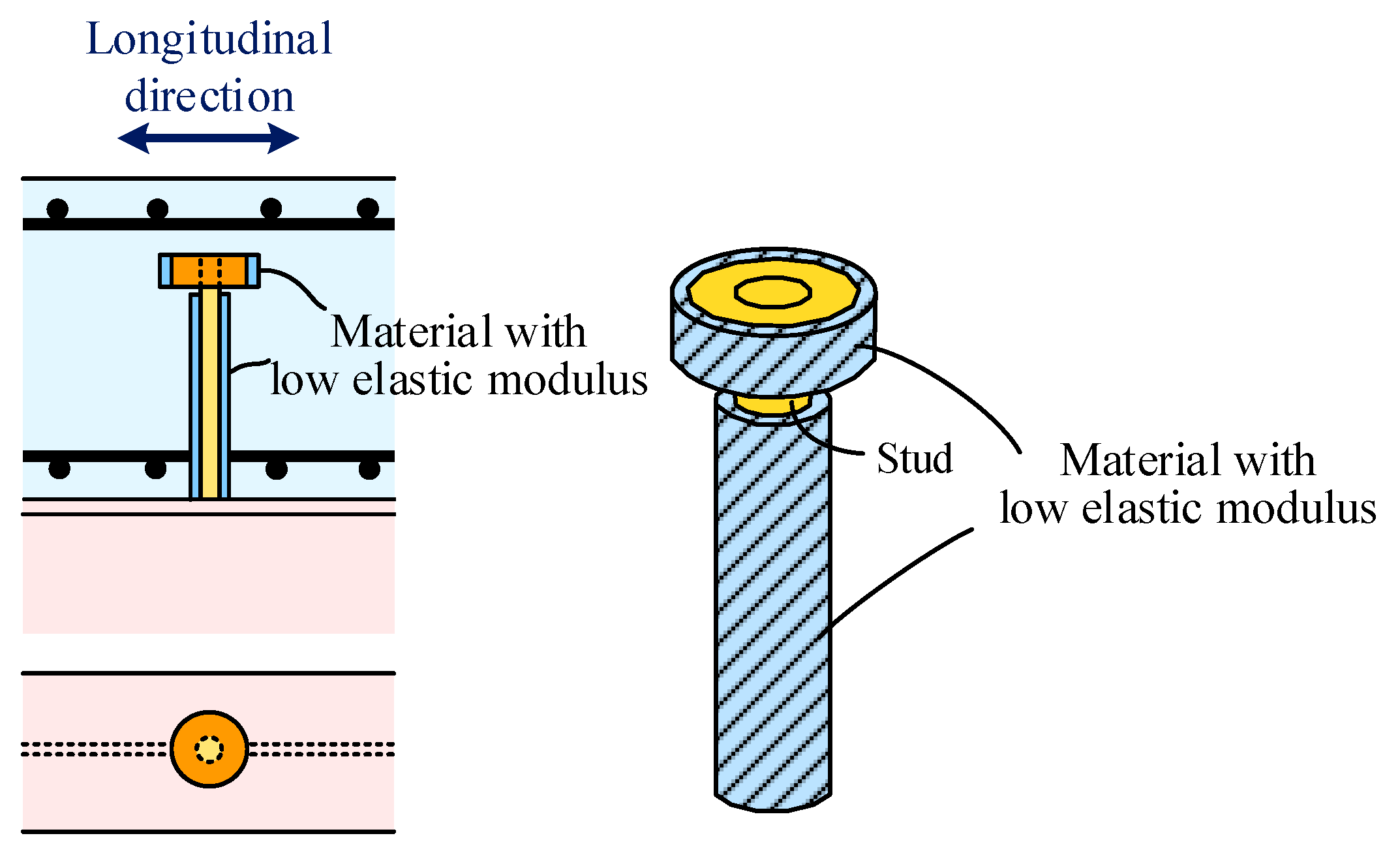


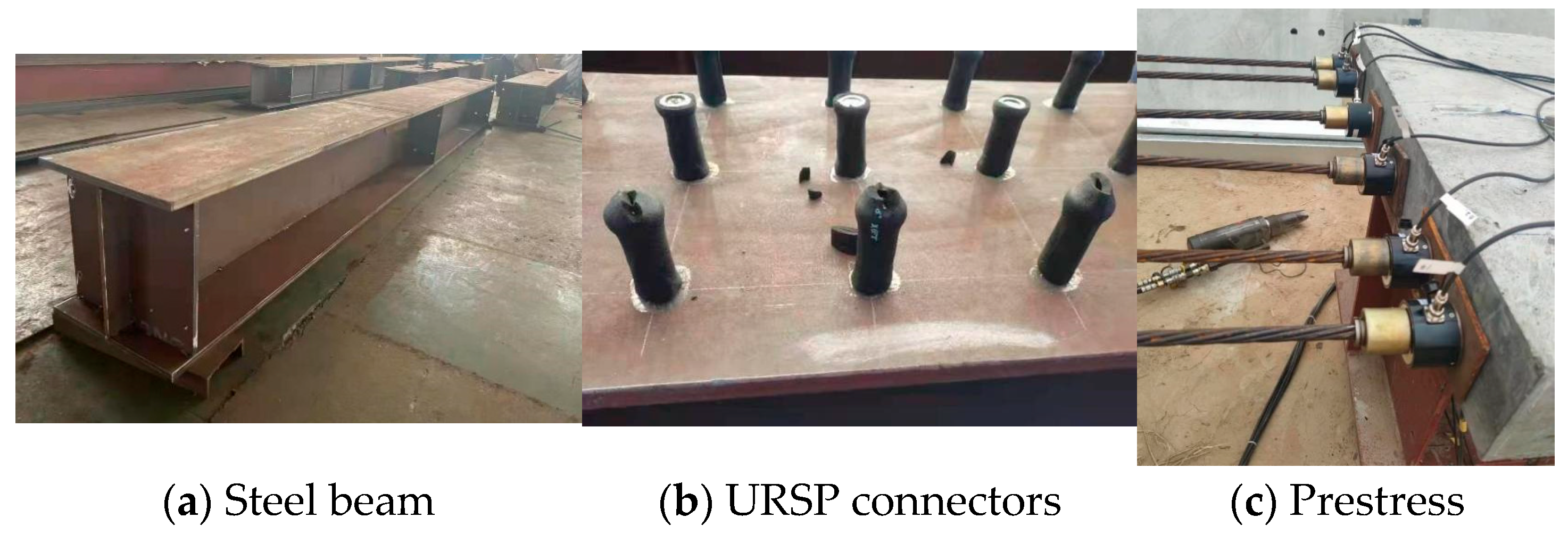
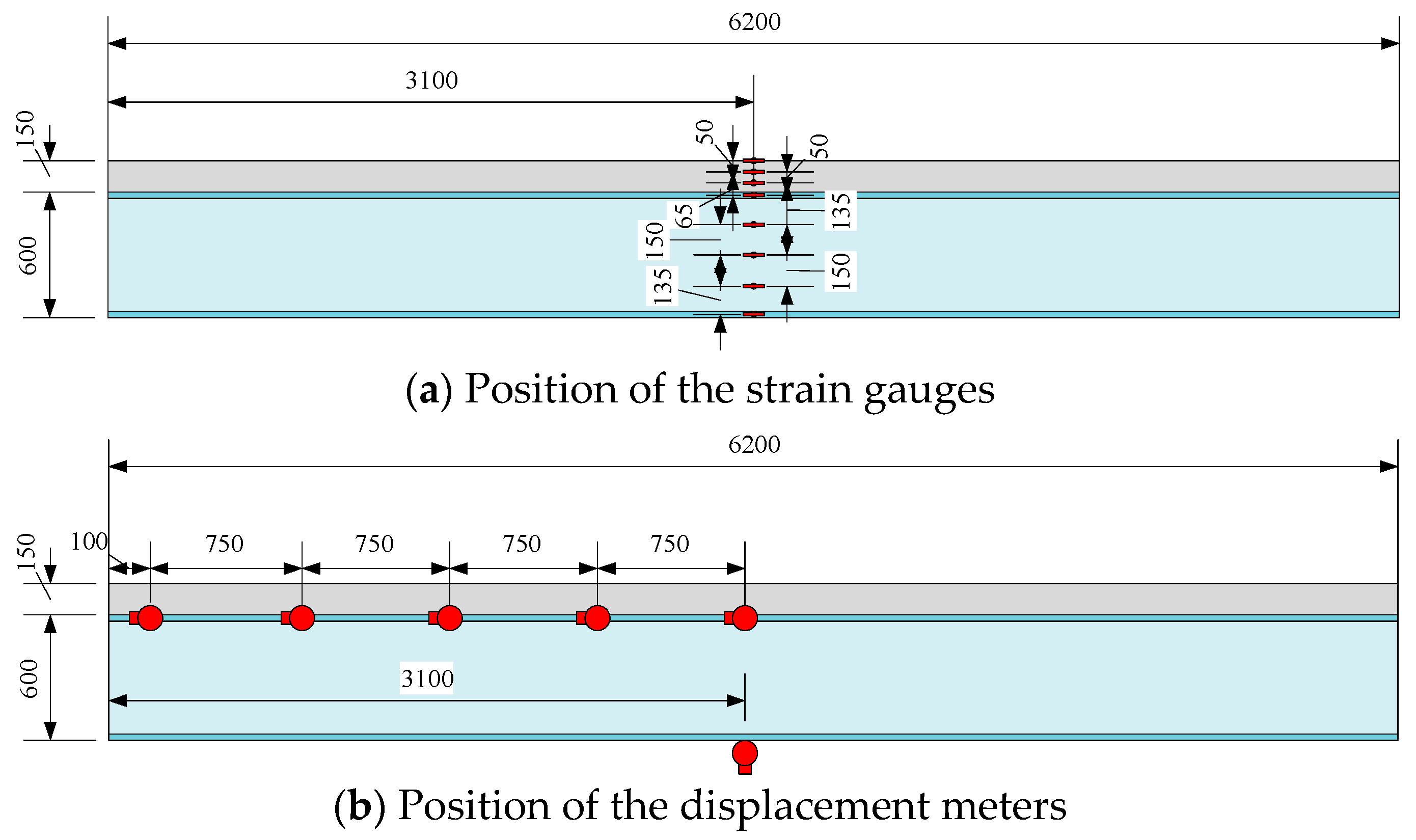
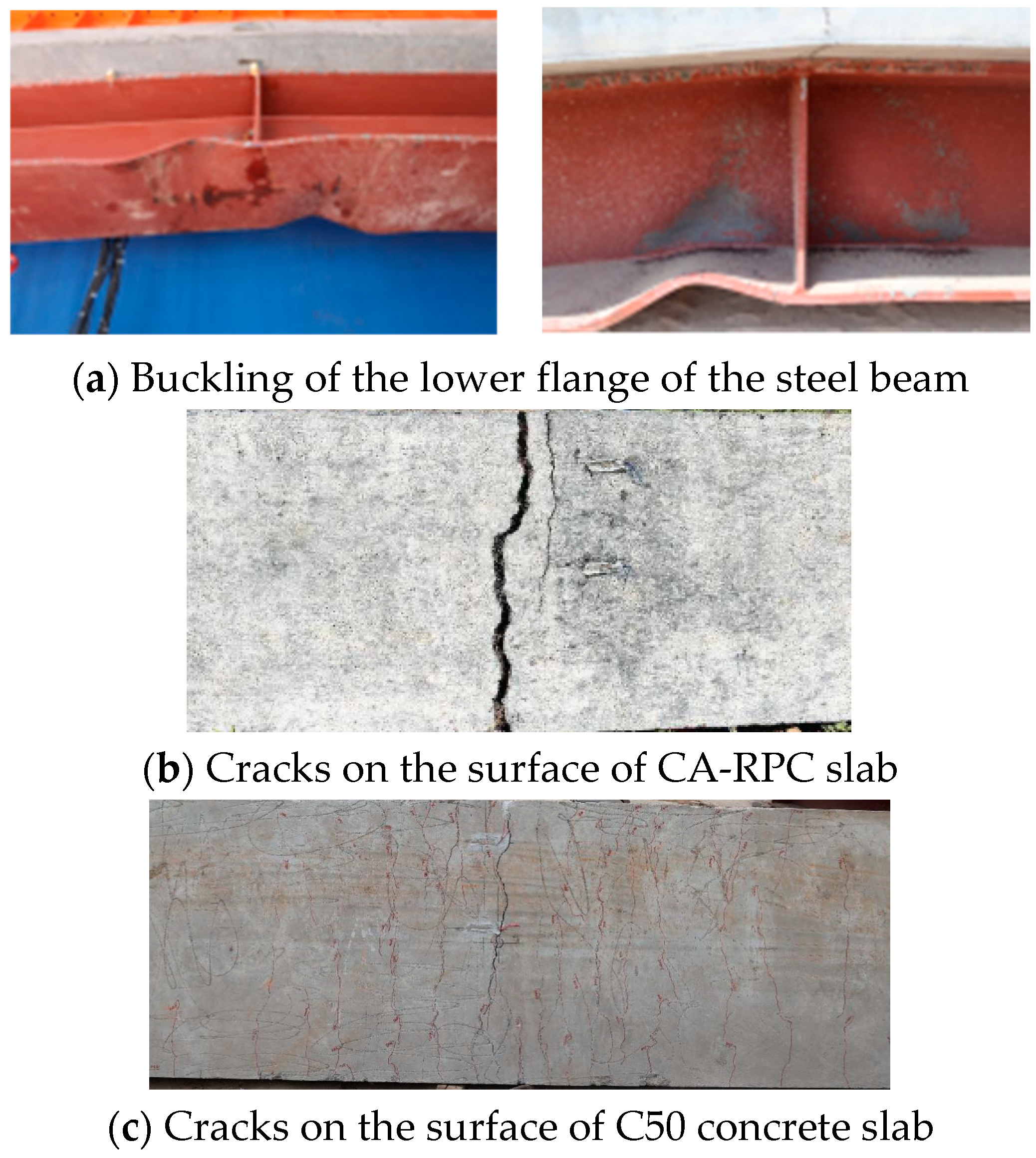
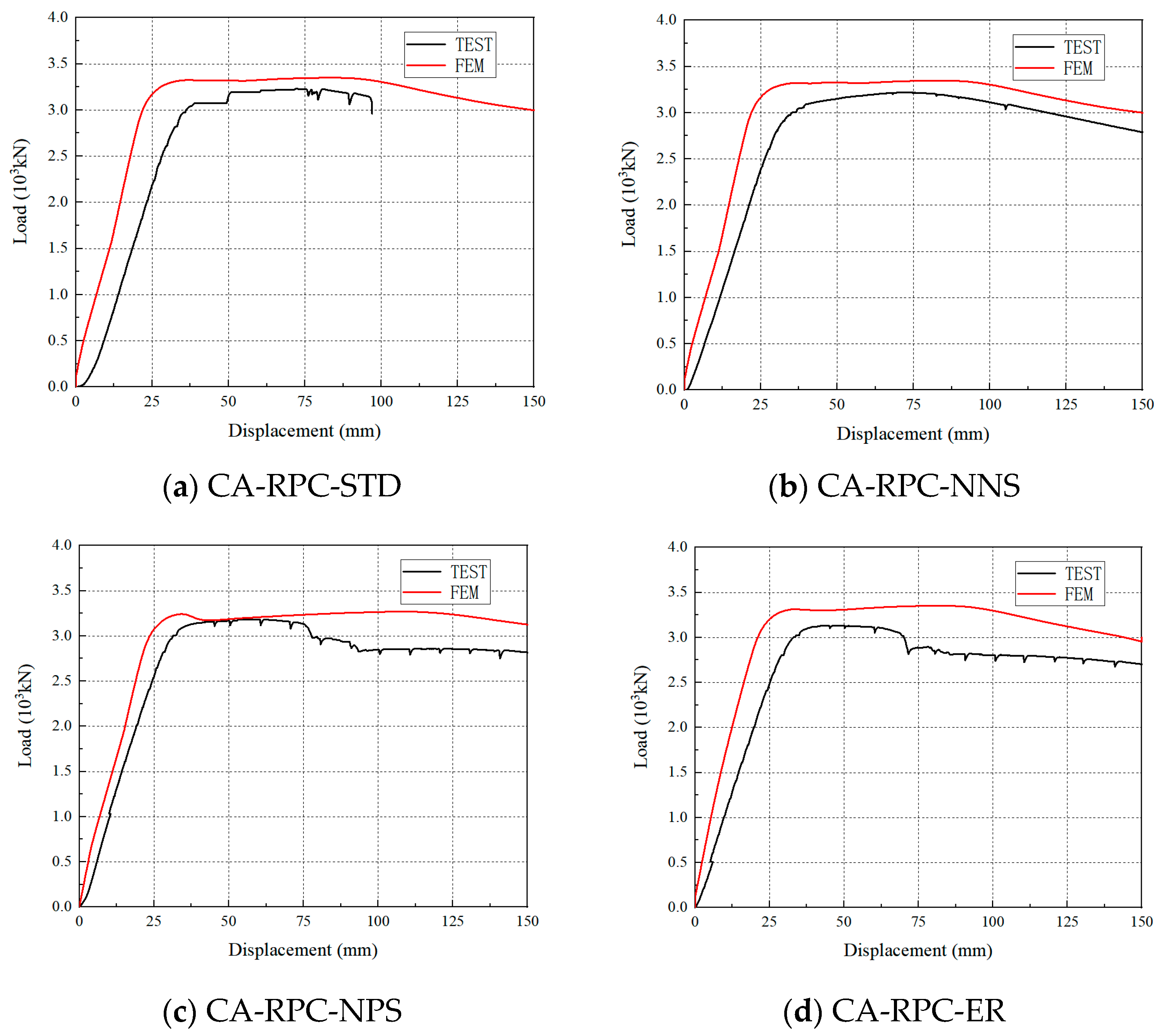


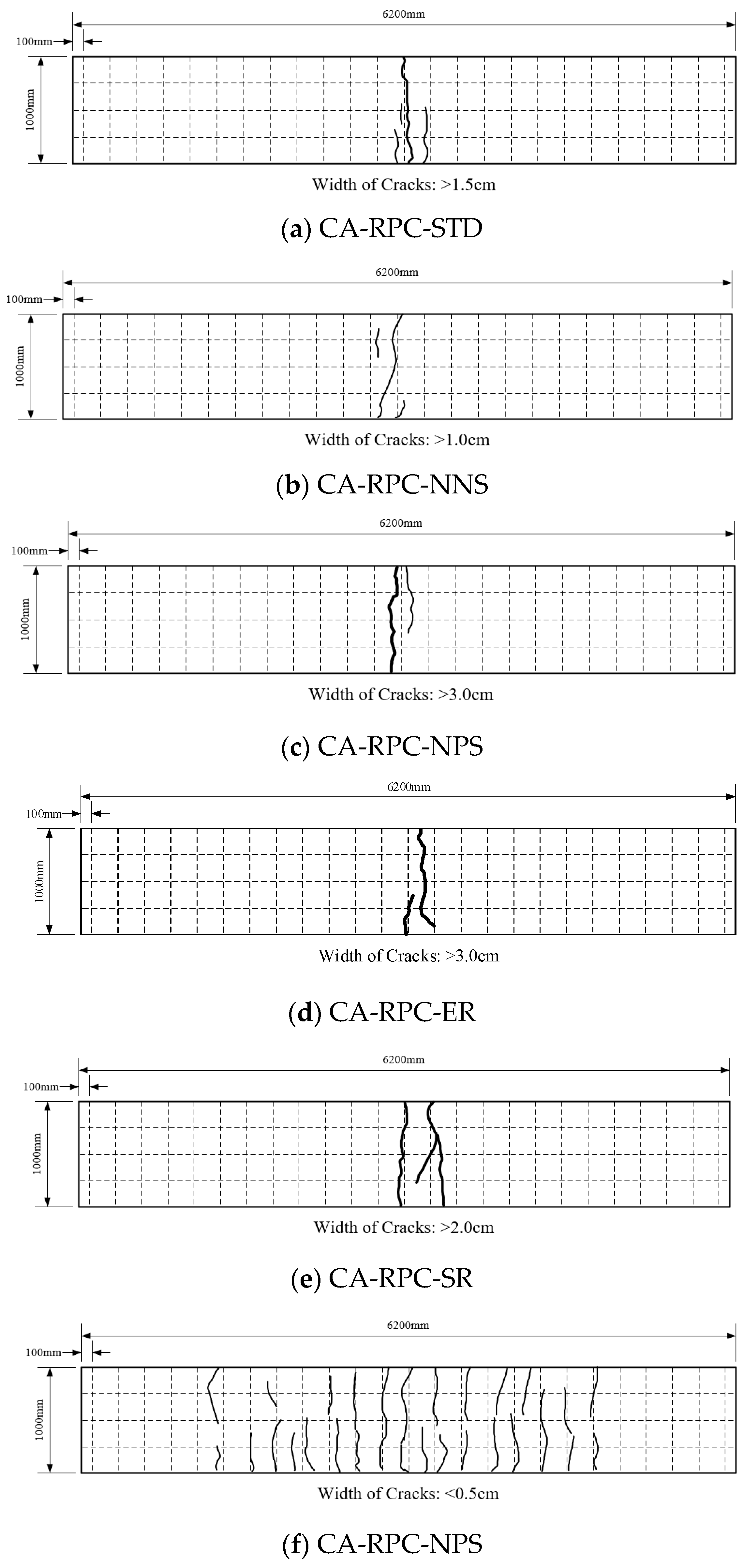
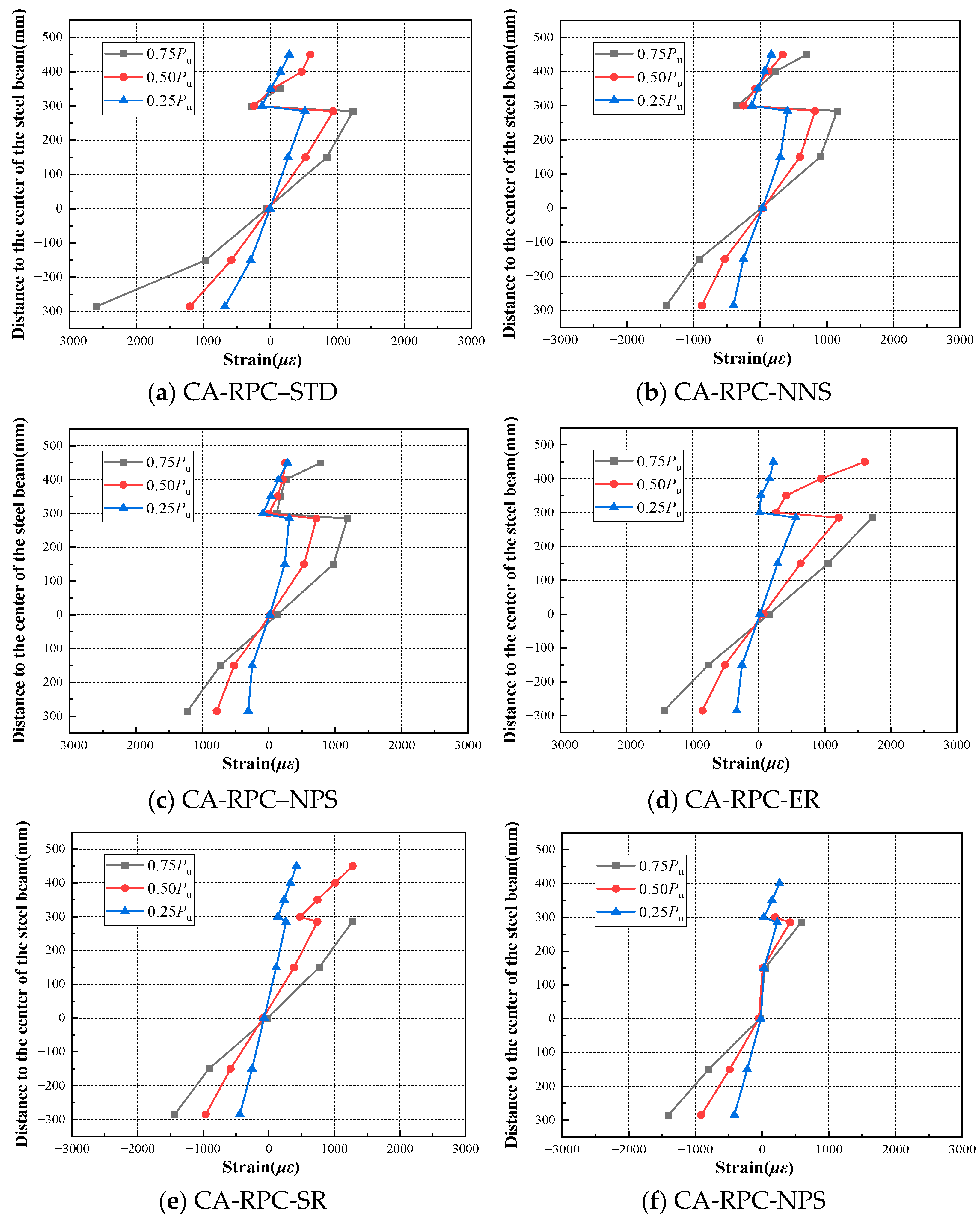

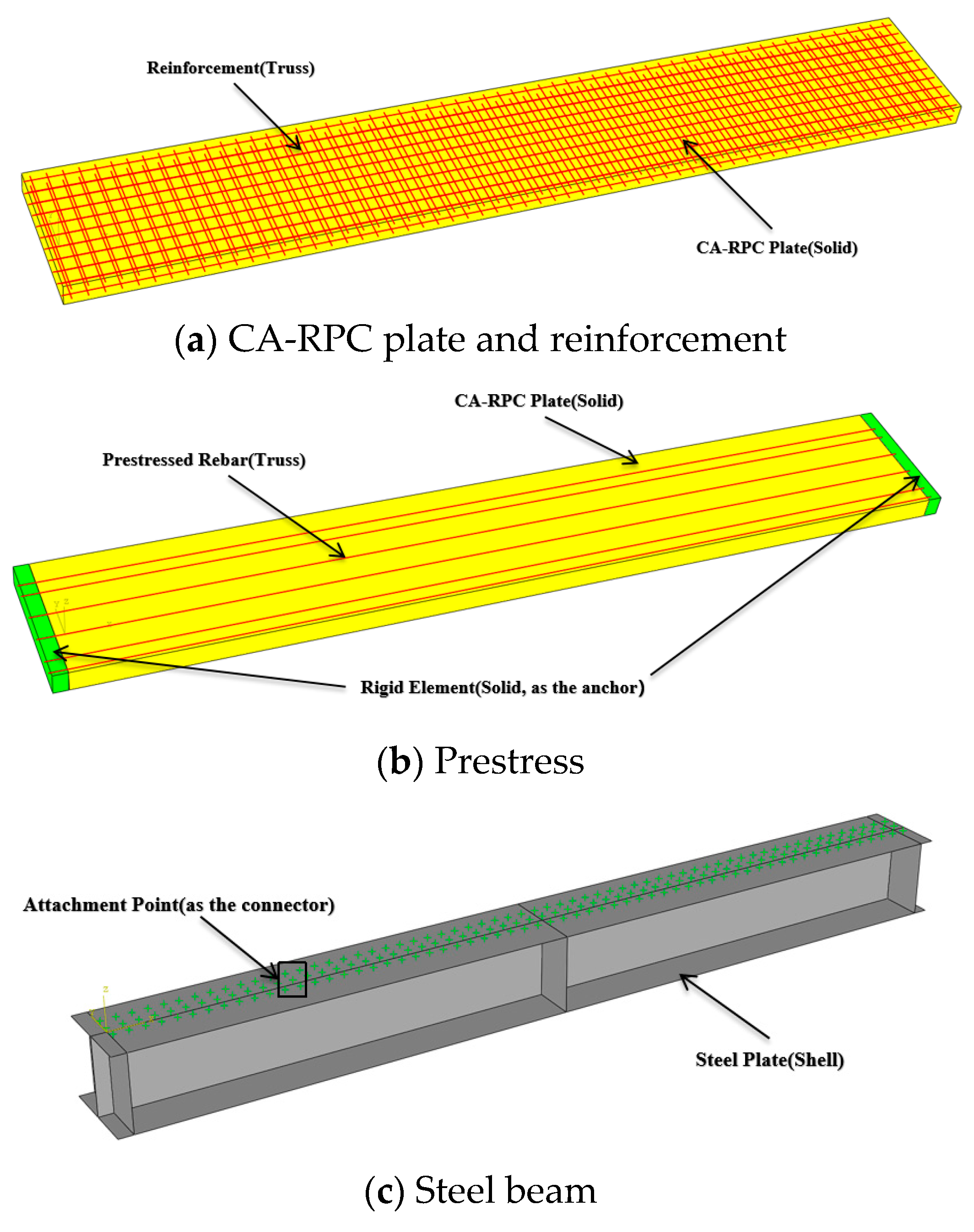

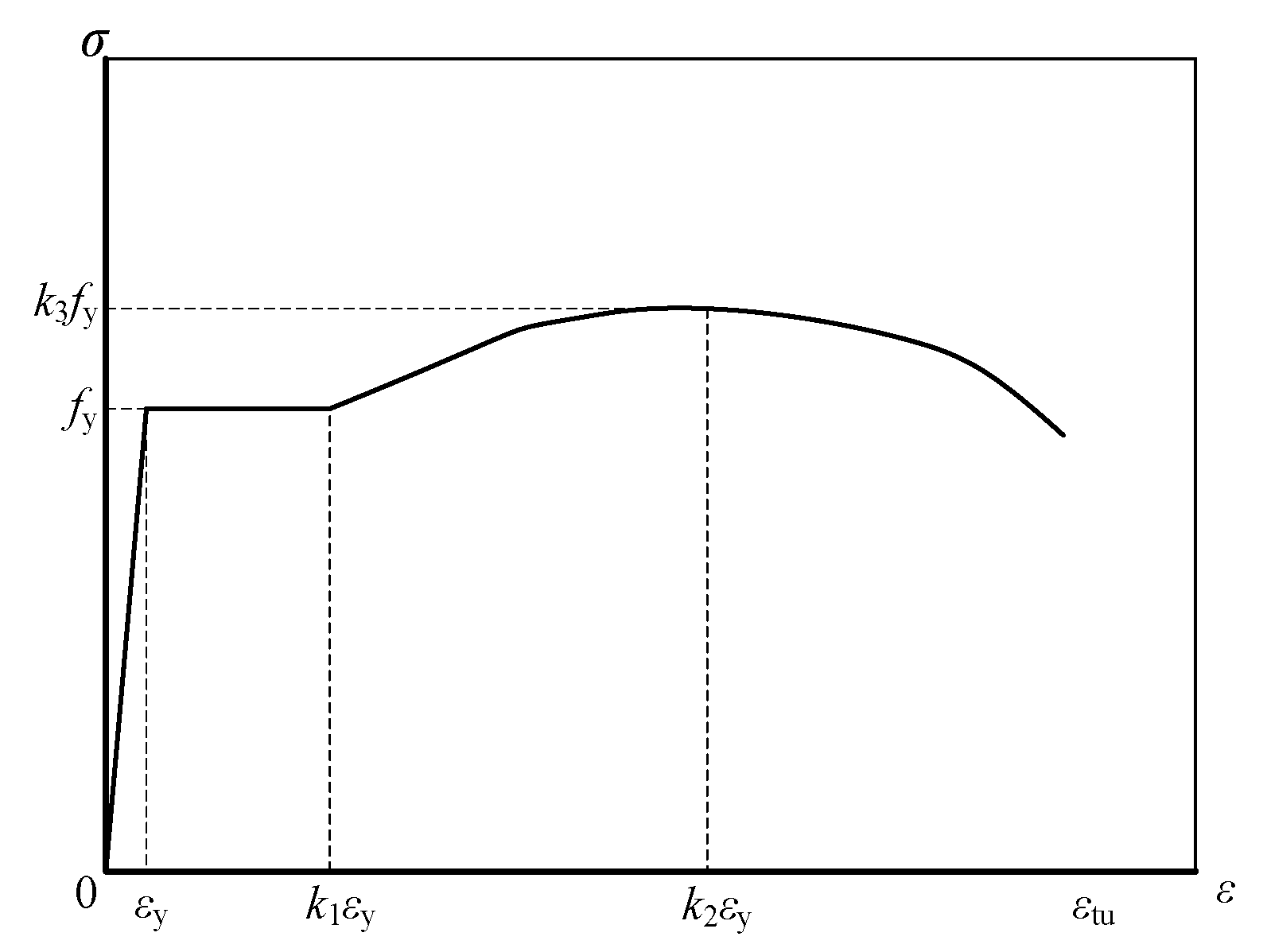
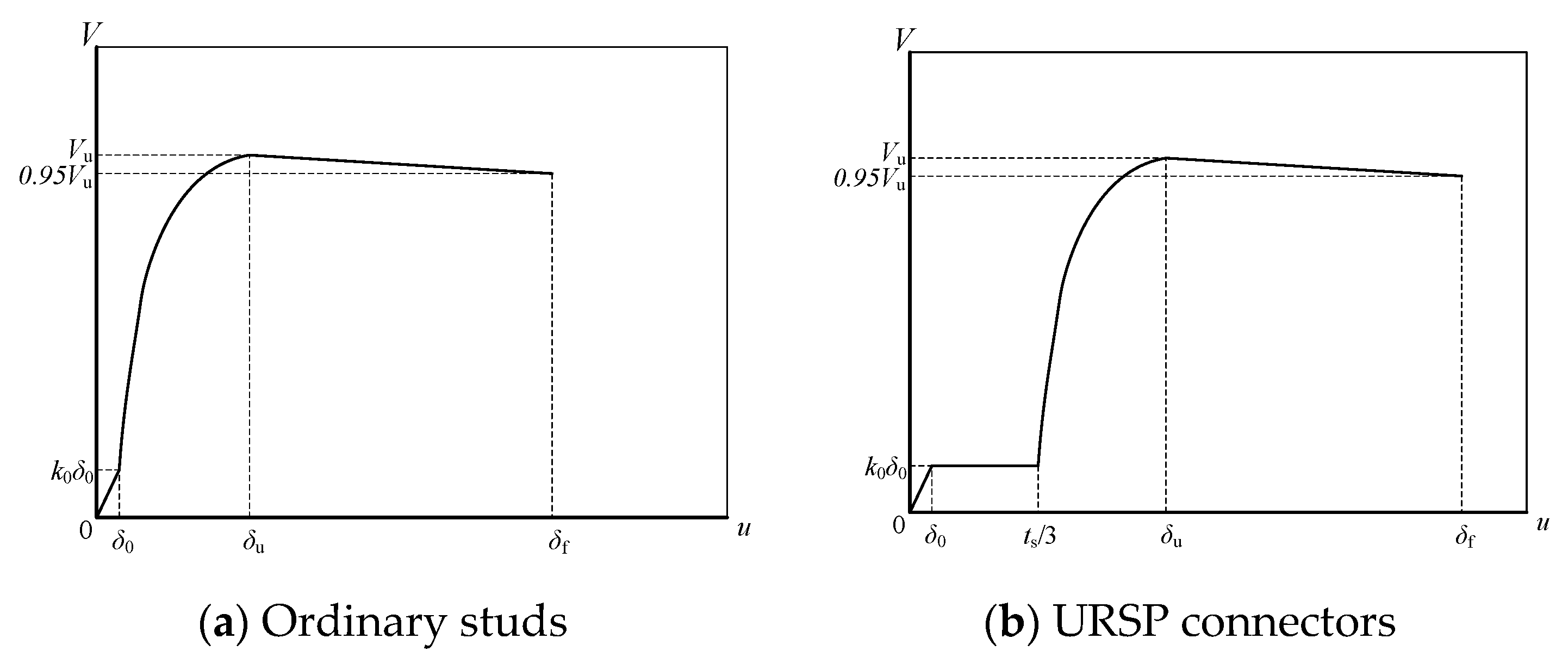
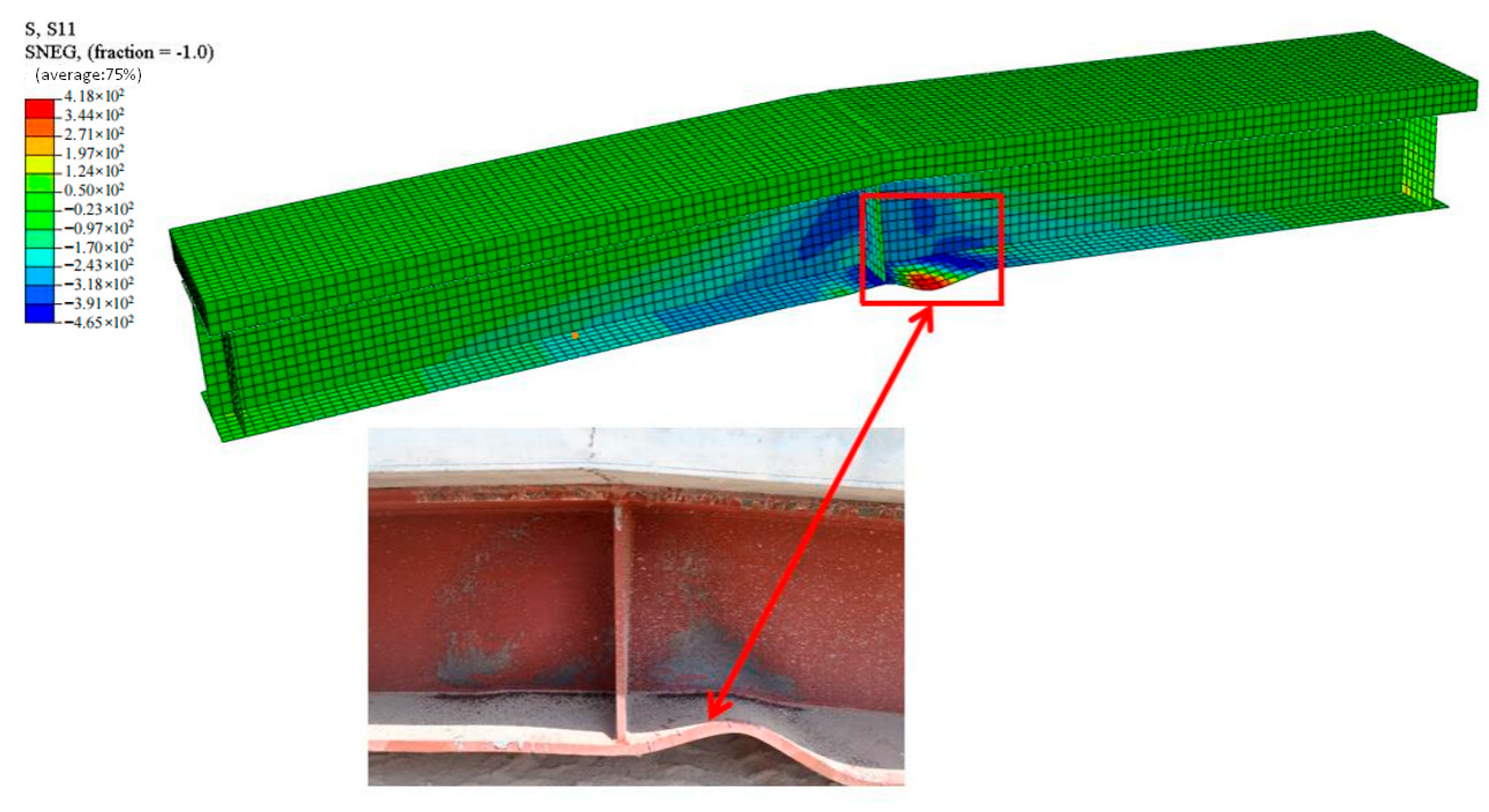


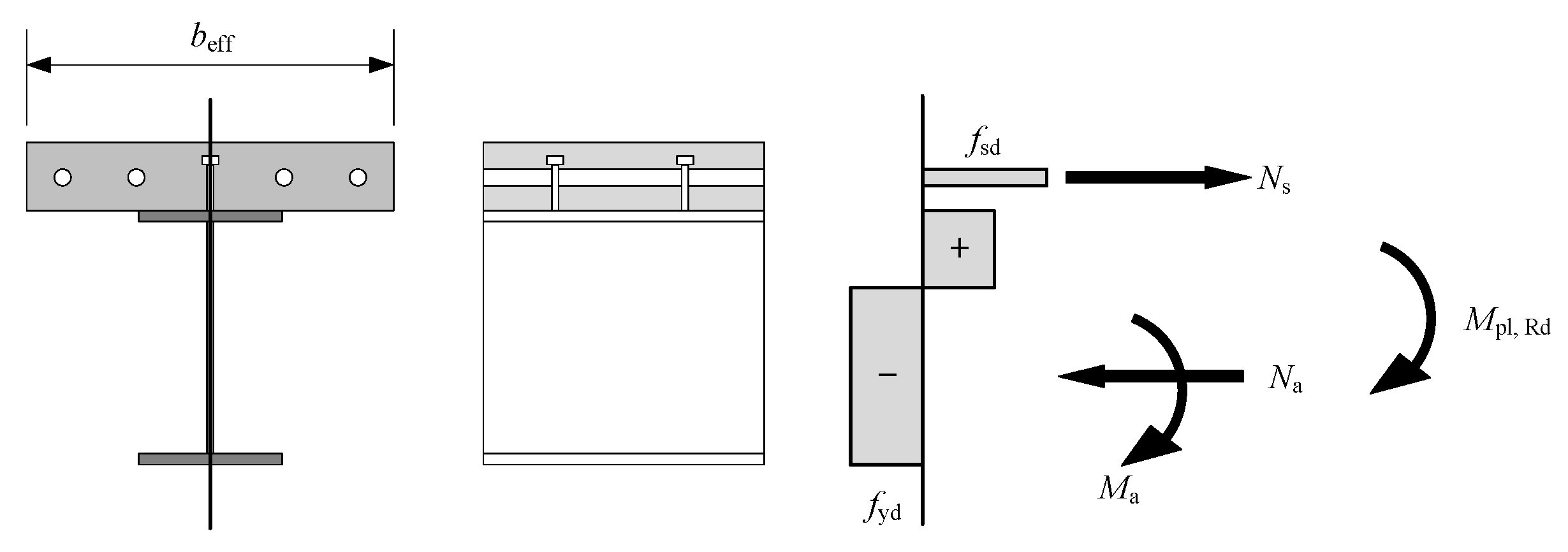
| Specimens | Type of Concrete | Prestress (kN) | Type of Connectors |
|---|---|---|---|
| CA-RPC-STD | CA-RPC | 900 | URSP |
| CA-RPC-NNS | CA-RPC | 900 | URSP, eliminating interfacial bonding |
| CA-RPC-NPS | CA-RPC | 0 | URSP |
| CA-RPC-ER | CA-RPC | 0 | URSP in the center, ordinary studs at the edges |
| CA-RPC-SR | CA-RPC | 900 | Ordinary studs |
| C50-NPS | C50 | 0 | URSP |
| No. | Position | Thickness (mm) | Width (mm) | Cross-Sectional Area (mm2) | Yield Load F (kN) | Yield Strength fy (MPa) | Ultimate Load Fu (kN) | Ultimate Strength fu (MPa) |
|---|---|---|---|---|---|---|---|---|
| 1 | Flange | 30 | 20 | 600 | 190.8 | 318.1 | 281.7 | 469.5 |
| 2 | Flange | 30 | 20 | 600 | 227.6 | 379.3 | 314.3 | 523.9 |
| 3 | Flange | 30 | 20 | 600 | 231.9 | 386.5 | 313.8 | 523.0 |
| Average value | 216.8 | 361.3 | 303.3 | 505.5 | ||||
| 4 | Web | 20 | 20 | 400 | 166.1 | 415.2 | 215.5 | 538.7 |
| 5 | Web | 20 | 20 | 400 | 169.3 | 423.2 | 220.7 | 551.8 |
| 6 | Web | 20 | 20 | 400 | 169.5 | 423.9 | 217.9 | 544.8 |
| Average value | 168.3 | 420.8 | 218.0 | 545.1 | ||||
| Diameter (mm) | Type | No. | Yield Strength fy (MPa) | Ultimate Strength fu (MPa) | fu/fy |
|---|---|---|---|---|---|
| 10 | HRB400 | 1 | 414 | 594 | 1.44 |
| 2 | 427 | 606 | 1.42 | ||
| 3 | 417 | 598 | 1.44 | ||
| 4 | 422 | 601 | 1.42 | ||
| 5 | 423 | 606 | 1.43 | ||
| 6 | 416 | 601 | 1.44 | ||
| Average value | 420 | 601 | 1.43 | ||
| Type | Compressive Strength Fcu (MPa) | Average Value of Compressive Strength fcu,m (MPa) | Tensile Strength fts (MPa) | Average Value of Tensile Strength fts,m (MPa) | ||||
|---|---|---|---|---|---|---|---|---|
| CA-RPC | 129.9 | 138.1 | 131.8 | 134.8 | 8.2 | 9.1 | 9.0 | 8.8 |
| 143.0 | 139.6 | 126.4 | 8.9 | 8.8 | 8.7 | |||
| Name of the Specimen | Fcr (kN) | Fy (kN) | Pu (kN) | Pu/Fcr | Pu/Fy | wy (mm) | wu (mm) | wu/wy |
|---|---|---|---|---|---|---|---|---|
| C50-NPS | 210.32 | 2750 | 3015 | 6.0 | 1.10 | 49.2 | 163.4 | 3.24 |
| CA-RPC-ER | 388.22 | 2546 | 3132 | 2.6 | 1.23 | 67.0 | 152.1 | 2.27 |
| CA-RPC-NNS | 838.62 | 2824 | 3219 | 1.1 | 1.14 | 40.2 | 160.1 | 3.98 |
| CA-RPC-NPS | 456.52 | 2652 | 3183 | 2.0 | 1.20 | 57.3 | 160.1 | 2.79 |
| CA-RPC-SR | 627.87 | 3127 | 3377 | 5.6 | 1.08 | 58.9 | 150.3 | 2.55 |
| CA-RPC-STD | 799.54 | 2485 | 3230 | 1.5 | 1.30 | 32.1 | 98.0 | 3.05 |
| Parameters | Value |
|---|---|
| Dilation Angle | 30° |
| Eccentricity | 0.1 |
| fb0/fc0 | 1.05 |
| Kc | 2/3 |
| Viscosity Parameter | 0.0001 |
| Poisson’s Ratio | 0.2 |
| Name of the Specimen | Fcr, FEM (kN) | Fcr, test (kN) | Fcr, FEM to Fcr, test Ratio |
|---|---|---|---|
| C50-NPS | 238.37 | 210.32 | 1.13 |
| CA-RPC-ER | 434.25 | 388.22 | 1.12 |
| CA-RPC-NNS | 854.74 | 838.62 | 1.02 |
| CA-RPC-NPS | 504.45 | 456.52 | 1.10 |
| CA-RPC-SR | 747.16 | 727.87 | 1.03 |
| CA-RPC-STD | 841.16 | 799.54 | 1.05 |
| Name of the Model | Concrete Material | Prestress (kN) | Type of Connectors |
|---|---|---|---|
| CR-9-U | CA-RPC | 900 | URSP connectors |
| CR-0-U | CA-RPC | 0 | URSP connectors |
| CR-9-S | CA-RPC | 900 | Ordinary studs |
| CR-0-S | CA-RPC | 0 | Ordinary studs |
| C-9-U | C50 | 900 | URSP connectors |
| C-0-U | C50 | 0 | URSP connectors |
| C-9-S | C50 | 900 | Ordinary studs |
| C-0-S | C50 | 0 | Ordinary studs |
| Name of the Specimen | Experimental Results Mexp (kN·m) | Calculation Results Mcal (kN·m) | Mcal to Mexp Ratio |
|---|---|---|---|
| C50-STD | 4522.4 | 4288.0 | 0.948 |
| CA-RPC-ER | 4698.0 | 4288.0 | 0.913 |
| CA-RPC-NNS | 4828.5 | 4288.0 | 0.888 |
| CA-RPC-NPS | 4774.2 | 4288.0 | 0.898 |
| CA-RPC-SR | 5065.1 | 4288.0 | 0.847 |
| CA-RPC-STD | 4845.7 | 4288.0 | 0.885 |
| Average value | 0.897 | ||
Disclaimer/Publisher’s Note: The statements, opinions and data contained in all publications are solely those of the individual author(s) and contributor(s) and not of MDPI and/or the editor(s). MDPI and/or the editor(s) disclaim responsibility for any injury to people or property resulting from any ideas, methods, instructions or products referred to in the content. |
© 2024 by the authors. Licensee MDPI, Basel, Switzerland. This article is an open access article distributed under the terms and conditions of the Creative Commons Attribution (CC BY) license (https://creativecommons.org/licenses/by/4.0/).
Share and Cite
Zhong, X.-Y.; Zhuang, L.-D.; Ding, R.; Tao, M.-X. Experimental and Numerical Study on the Performance of Steel–Coarse Aggregate Reactive Powder Concrete Composite Beams with Uplift-Restricted and Slip-Permitted Connectors under Negative Bending Moment. Buildings 2024, 14, 2913. https://doi.org/10.3390/buildings14092913
Zhong X-Y, Zhuang L-D, Ding R, Tao M-X. Experimental and Numerical Study on the Performance of Steel–Coarse Aggregate Reactive Powder Concrete Composite Beams with Uplift-Restricted and Slip-Permitted Connectors under Negative Bending Moment. Buildings. 2024; 14(9):2913. https://doi.org/10.3390/buildings14092913
Chicago/Turabian StyleZhong, Xuan-Yang, Liang-Dong Zhuang, Ran Ding, and Mu-Xuan Tao. 2024. "Experimental and Numerical Study on the Performance of Steel–Coarse Aggregate Reactive Powder Concrete Composite Beams with Uplift-Restricted and Slip-Permitted Connectors under Negative Bending Moment" Buildings 14, no. 9: 2913. https://doi.org/10.3390/buildings14092913








